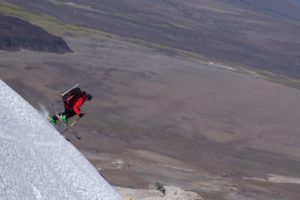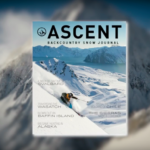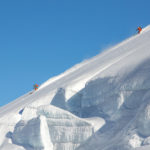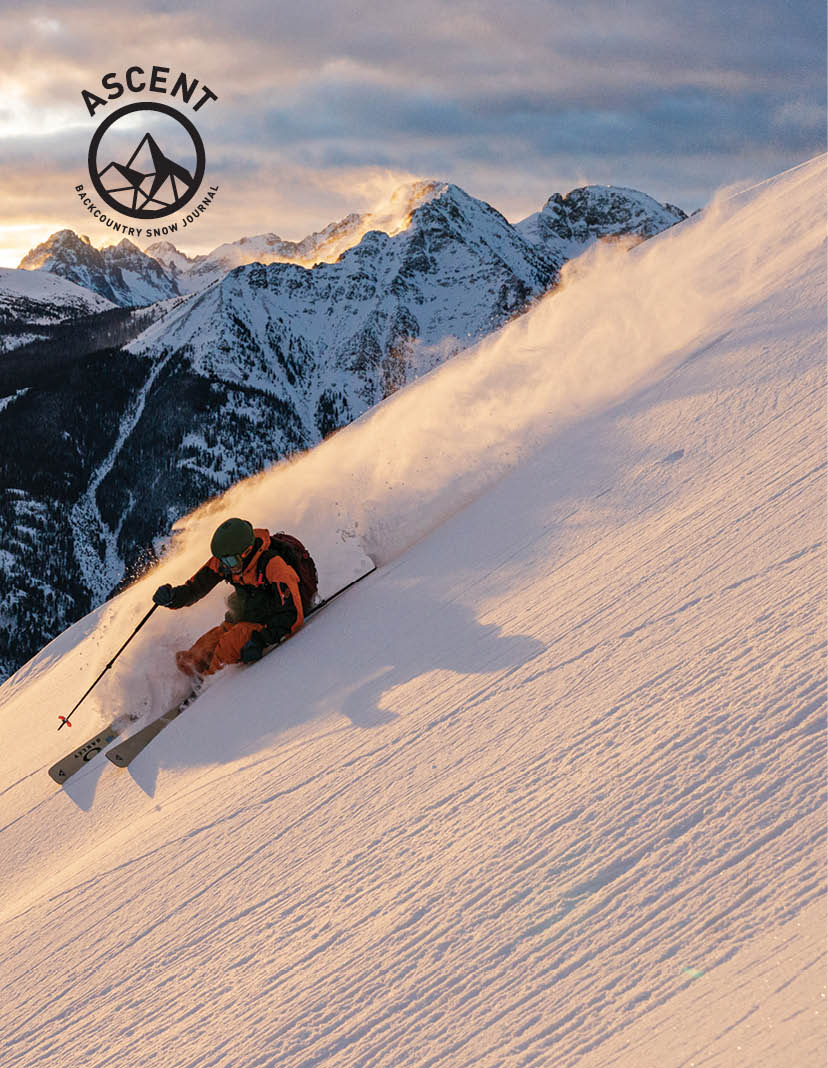It has been said that one good thing can lead to another, maybe even more so in ski mountaineering. In May of 2010, I found myself with my buddies cresting out on 21,000-foot Coropuna in southwestern Peru in the Cordillera Occidental. As we gazed out over the edge of the Atacama desert at the dots on the horizon, the Cordillera Real of Bolivia sat on one side, and the Cordillera Blanca in northern Peru on the other, the view was only obstructed by massive volcanos- a few still smoking- the names of which we had no clue. But, what we did know without question, is that we had to come back to do more climbing and skiing.
In the history of skiing in this relatively unknown and unexplored desert range, I could find only one account of two climbers bringing ski gear. The Occidental is not a typical Andes mountain range, but rather is composed almost exclusively of volcanos dotting the vast landscape. There are 137 active volcanos many which emit plumes of gas and ash, most with massive ancient lava flows fanning out to cover the flat landscape for miles below. They don’t appear to be what a ski mountaineer would gravitate towards which is backed up by the scarcity of documented skiing descents. We took a risk planning a trip to Coropuna, but it paid off. Not only did we get a second ascent, we had incredible skiing and a first ski descent of the massifs Baraco line. While the northern exposed slopes of these massive 6,000 meter peaks are bare much of the year, the southern slopes may have glaciers and hold snow despite the arid ecology from which they rise. You won’t find powder, but you will find massive cirques and steep slopes of hard smooth snow, and in May, corn snow conditions. What you won’t find are people; it’s ski mountaineering bliss. From the summit of Coropuna, after spotting two massive peaks and then experiencing some of the best high altitude skiing ever, we kept this secret stash in the backs of our minds.
We had ambitions to return to Tibet in the winter of 2016, but were not successful in twisting the arms of the Chinese Mountaineering Association to issue a permit for wintertime. The entire Himalaya range in Tibet was closed for the second winter leaving us with failed plans, and nothing to look forward to as it related to getting our fix with an expedition. By March, we had not been above 6,000 meters for over a year, something that had not happened in over a decade. We were like junkies without junk, and going crazy without an expedition to look forward to. Over beers, Jim Gile, brother Steve, and I found ourselves eager to go anywhere, slightly depressed with our dry spell, and an empty spring to fill. Immediately I suggested “those two big peaks we saw from Coropuna….” I was given marching orders to figure out a plan.
I pored through photos, and then clicked into Google Earth as I did to find Coropuna, and started looking for white dots from my virtual space ship. I honed in on three masses to the west of Coropuna and discovered they were the peaks we had seen. Zooming in, I learned the peaks were 20,600 foot Ampato, and a close neighbor being 19,600 foot Sabancya, which even on Google Earth was clearly active with a smoking summit. Research on the peaks was sparse on the Internet, with dozens of guide companies advertising “climb with us up snowy Ampato,” but little if any actual accounts of people climbing in the area. There was nothing about skiing. I reached out to a half dozen guide companies to find one that could get us to the peak and a man to watch base camp, but only one got back to me explaining “ Oh, that peak, everyone has it on their websites, but I don’t know of anyone that has ever actually been there….” I could not locate the guy from our last trip to Coropuna and by late April, had nothing definitive for a looming mid-May trip.
With nothing to lose, I reached out to our Himalaya outfitter, Kari Kobler; he knew a guide company he used for the more popular Cordillera Blanca area in northern Peru, and would check to see if he had any contacts in Arequipa. A week later, I got an email from a small operator in Arequipa excited and ready to help us out. We booked flights for our team consisting of all Aspen climbers; Mike Maple, Jon Gibans, Jim Gile, my twin Steve and myself.
Disembarking an airplane in Arequipa, you find yourself on the tarmac surrounded by massive 6,000 meter peaks towering above the city. There are no foothills; just the massive volcanic peaks. I’ve never really seen a city like Arequipa, made mythical by the fact that many streets are built on top of the same paths the Incas used 700 years ago, and lined with walls they built from the volcanic white rock found everywhere, and also being the main material used in the construction of most homes over the years. It’s a modern city with an ancient feel spanning many cultures over the centuries. The streets are clean, and while Arequipa has a booming tourist industry, it is mainly regional travelers with very few international tourists. The people are warm, and although the city is not terribly developed, Arequipa is a culinary center in South America with a number of cooking schools. In all my travels, and comparing it to even Aspen known for fine dining, Arequipa is a foodies’ heaven. For $20, you can have a gourmet meal comparable to anywhere in the world. It’s fantastic!
We spent a day shopping for food and sightseeing, and came across an interesting museum that had an exhibit called Juanita, The Inca Snow Queen. We learned of an ancient ritual that included human sacrifices on the very mountain we were headed to. The exhibit was a history of horrific human sacrifice that took place centuries earlier. The Inca would isolate small children born without blemishes, and hold them in high esteem until they were about 12 years old. Then they would walk to the high volcanic peaks throughout the Andes and offer these children as human sacrifices to the Gods in an effort to squelch potential eruptions and earthquakes. All told, there have been 17 such frozen bodies found throughout the Andes, and this museum had Juanita; found on the summit of Ampato. The exhibit told the story of how they would cut grass from the lowlands, and then line the entire back side of Ampato to allow for traction to climb the peaks. Artifacts included “climbing” boots made from hemp and cotton, cold weather garments, food bags, firewood- everything needed to summit a 20,000 foot peak. Amazingly, on the backside of the peak, the trail is still intact, complete with the grass laid 700 years ago along the entire route. Juanita is now encased in a glass walled freezer, her brown skin and long black hair completely preserved. She is not a mummy, but rather frozen perfectly in time to where an autopsy revealed her last meal, including copious amounts of ancient beer and hallucinogenic drugs, given to her on the summit before what an MRI revealed was a death blow that crushed her skull. It’s a ghoulish exhibit, but incredibly amazing. Despite their horrific mission, the Incas were the first generation of Andes mountaineers.
After the day of sightseeing, we drove the 5 hours to about 12,000 feet. We spent the first night car camping, and the next day did an acclimation hike. After another night, we set off to base camp sitting at about 14,000 feet. The camp was situated on volcanic dust and rock below the glacier, with only boulders to offer protection from the constant winds that buffeted the peak from seemingly all directions. The closest peaks were on the horizon at the limits of our unaided vision, Ampato and Sabancya rising out of the edge of the desert as lonely giants.
The first notable aspect of these peaks was evident as unpleasant wind lifted fine dust that coated everything immediately. After a couple days of camping, we looked more like coal miners than ski mountaineers, and tent door zippers were rendered useless, grit destroying the teeth. This was a beautiful but inhospitable place, an aspect that explained why we were the only people for miles. But the glacier above was white, and the upper slopes at least appeared to hopefully be worth the discomfort. We settled into our tents, used duct tape to seal off the doors as best we could, and looked forward to clean, fresh air on the route.
The day after getting to base camp, we immediately set off up the peak to check out the route and acclimate for the 6,000 foot single push to the peak. The lower moraine was easy walking, and soon we reached the lower slopes of the glacier. The snow was rock-hard, and moderately rough, but totally skiable. This excited us. When you head off to these types of peaks, you really don’t know what to expect. A few times over the years, we dragged all the gear across the globe to find no skiing. Until you see that there is skiable snow, it’s a source of anxiety. This was immediately relieved. We continued up to about 17,000 feet and, through our camera lenses, could see that the snow became smoother as we looked up. The mood changed from anxiety, to anticipation. We realized we needed another day of hanging out to be fully acclimated and, combined with the dust and cold wind, realized it was going to be a long wait.
After another day, we were ready to go. We woke at 3 in the morning, and fueled up. We were greeted with snow flurries as we headed out, but the sky soon turned star-filled, completed with the edge of the Southern Cross. As the sun began lighting the sky, we reached the edge of the glacier, and stepped into our crampons. As it crested the horizon, the sky took on a beautiful magenta hue, and there was no wind. We had a perfect day! We ascended to where the glacier began in earnest above the dry glacier, and were greeted with glass-smooth snow, the texture and look of white marble. We front-pointed the upper slopes that steepened as we ascended. With the smooth snow, our hearts raced in anticipation of the skiing, with the thin air dictating a snail’s pace despite our adrenaline.
By the time the sun hung in the sky for the day, we crested into the massive crater. Looking at this from below on the drive in, the size of the bowl before was hard to imagine; from afar, we knew it was big, but it’s difficult to comprehend the mass of these peaks until you are experiencing them. The crater rim is 500 feet above an undulating field of snow and ice hundreds of feet deep. It stretches for about a mile in all directions. We climbed through the only break in the circumference of the rim, which over the centuries has failed to stop the flow of ice as gravity pulls it down towards the steep face. On the face, the wind and shade create a very cold ascent, but with the sun shining through this gap, the enclosed nature of the natural amphitheater magnified the radiant heat to a scorching temperature. We shed layers to cross over to the normal route, ascending steeply and most directly to the summit rim.
I led the team across and when the pitch steepened to a wall in front of me, I clicked out of my skis and tied them to my pack. The hard crust of the snow was deteriorating quickly under the direct sun. I immediately broke through and found my legs wading through bottomless mush. “This is going to avalanche guys….” Two years before, on the exact face at the same time of year and day, this face had slid in a massive avalanche that took two lives. I was nervous.
Steve came up to assess the situation, and his conclusion was the same. We backed off to the flat bottom to find better perspective. . It was clear that we could not ascend the rim wall at any point in the direct sun. We looked for opposite facing slopes. Fatigue from exerting up the face coaxed an agonizing feeling. The only possible wall was in the opposite direction in the furthest possible line from where we were standing. It was getting moderately late, so briefly we discussed the situation and decided we would go for it, but we had to hurry. The sun was getting higher and hotter.
I was already on my skis ready to go, so I headed out. I contoured the wall only to find large crevasses in my approach. Steve headed back the direction we came and then veered off in the direction of the wall in what added even more distance to our objective. I crossed over and in a single line, everyone followed Steve. The route was up a moderately steep shoulder that would avoid the steepness of the wall, and lead to a small break in the rock wall which graced the top of the rim. As we slowly proceeded, the length of the adventure, the intense heat, and the altitude above 20,000 feet agonizingly slowed us. We would later recall this as one of the most difficult high altitude treks ever.
I met up with Steve and looked at a knife ridge leading to the rim. I took my skis off and used them as crutches to balance my weight as I ascended to the crest 50 yards in front of me. I reached the high point and gazed out at the desert below, and saw the edge of Arequipa on the horizon. It was a perfect day, only a light breeze which was welcomed after the inferno of the bowl below. Steve followed, and Jim, Jon and Mike came up after him.
The ridge was precarious with a sheer drop to the north on completely rotten snow, and to the other side, the bowl of the crater. I delicately clicked into my skis and waited. Once we were all ready, Steve skied the ridge carefully to the small gap and waited as the rest of us descended. Jim and Jon skied the steep face back towards our line of ascent and as I watched them ski the perfectly smooth slopes to the flat of the bowl, they became specs against a backdrop of pure white. I skied off the face to join them, and the initial turns were on a slight crust that warranted attention, but soon I found myself skiing the rock hard marble back to the flat. Steve and Mike joined us and we continued down the hard snow. The skiing was not hero snow given the hard nature- it was incredibly slick and we had to really pay attention-but it was smooth. By this time, we had been out for nearly 10 hours, and our legs were like rubber; we were running on fumes, and while the skiing was hugely satisfying, we were out of water and food, and needed to get back to camp. We skied to the end of the glacier and experienced the rougher more difficult snow on the lower face. If not for the thicker air, the skiing might have been too much for our tired bodies, but the day was perfect, the air had warmed comfortably, and we skied to the snowline and then shouldered our gear for the hike back to camp. We reached camp about 15 hours after we started, and our cook had drinks and lunch ready. We slept the remainder of the afternoon, only breaking for dinner, and woke up the next morning completely satisfied with the effort. We immediately began our plans for the neighboring peak, 19,600 foot Sabancya.
Reason would suggest that we should have acclimated for Ampatos’ 20,600 foot altitude by attempting Sabancya’s lower 19,600 feet. With limited time, we made the decision to go for the main objective first, however, because Sabancya was a bit of a trek from camp, and although it was covered with snow, we had no idea if it was skiable. Everything went as planned with Ampato, and with a few days left, we decided it was worth exploring the second peak. The day after Ampato we were in no condition to do more than rest, but the next day, we decided to hike over to the base of Ampato and figure out if there was a way to get from the desert floor through the moraine to the peak itself. We walked for a couple hours, our boots stirring up the fine volcanic dust the whole way, layering our clothing with dirt. We reached the moraine which was more an old volcanic rock wall, and pieced a route through it too the base. It entailed figuring out a bit of a maze, but it was definitely something that worked out fairly smoothly. With time running out, we decided that we would make our attempt on Sabancya the next day.
Again, we started out in the dark under stars and no wind; another perfect day. As we hiked across the desert, the sun started to break on the horizon which was a welcomed and planned use of time in that we needed a bit of light to go back through the maze. We crested the moraine and walked on a flat bench to the slopes of the peak. The face was extremely steep, and we stepped into our crampons and brought out our ice axes.
The snow on the initial slopes was rotten crust and we had to fight our way breaking a trail. The face was not possible so we veered toward a ridgeline adjacent to the face where the snow hardened. There were no crevasses, and the snow had enough softness to not warrant roping up or belaying. We proceeded up through rough albeit solid snow. The slope was definitely skiable, but it was not ideal. Hours went by like minutes, and we found ourselves cresting off the face onto the main ridge leading to a false summit. To our delight, the ridge was perfectly smooth, hard, marble-like snow. As we reached the flatter spot towards the summit, we realized it was a false summit and that the main summit was a bare rock ridge on the top of a massive crater. I proceeded past a steaming hot spot, and found myself at the foot of a small ledge of massive boulders which formed a summit. The main summit was down a ridge and across the crater, but it was smoking heavily, emitting a Sulphur and extremely toxic dark cloud. Our logistic person warned us not to step into the volcanic cloud, that it was lethal. We reached this high point a few feet lower than the main summit and decided to take this as our final destination.
The view was incredible. We looked across at two massive peaks, one being Coropuna which we stood on years before. Between, the Atacama stretched for miles in all directions. The day was pleasant with no breeze, but cool enough to stay bundled up. It was relatively early in the morning, and we enjoyed the views until the coolness pierced our fingers and toes and we saddled up. The ski across to the false summit was enough to get our ski legs warmed up and we regrouped at the crest. We looked down the ridge and the opposite slopes and discussed skiing this, not a small matter given our insistence on only skiing what we climb. However, we knew the slope would lead us close enough to our starting point, the snow was rock hard, and compared to the rough and crusty snow we ascended, we decided to take the small risk.
The snow was hard and smooth for the top third. As we descended bit by bit, the lower slopes welcomed us with a hybrid powder of sorts where wind from the opposite side had deposited a layer of drift that when touched by the sun created a soft layer on top of hard surface a couple inches below. It wasn’t powder, and it wasn’t corn, but it was smooth and soft. The slope steepened drastically making for effortless turns. The slope was dotted with a few islands of rocks, and we skied carefully, not letting the conditions get the better of us with the temptation to really let go with fast open-slope turns; a fall would have been serious. We skied, one at a time until we reached the base of the peak. Making the decision to ski something we had not climbed created a sense of anxiety, but now firmly at the flat base, we knew we had experienced skiing where no one ever had, with conditions that placed Sabancya as one of the best ski runs in our lives.
We walked back across the glacier under a cloudless blue sky that cannot be described or photographed, and we reduced to keeping a great secret of what the Atacama holds for the few that seek to experience it. Ampato graced our field of vision as we looked forward for our journey back, interrupted only by the quintessential look-back that anyone who climbs a mountain experiences as they walk away from a magnificent ascent and descent.
Recalling this adventure, the aspect that made this expedition so satisfying is that we truly ventured into an unknown. We could find no accounts of people climbing and skiing either of these peaks, making the effort a gamble. But in the process of taking on these types of objectives, a ski mountaineer goes with hope. We have gone on similar expeditions to peaks that were in some cases not skiable let alone climbable. When that happens, you make the best of things, but the reality is burned into your mind leaving you wanting resolution. Ampato and Sabancya proved to be the resolution that we were after, and more importantly, left us with a great memory to seek more.















